
Ship's Surgeons as Barbers Page Menu: 1 2 3 4 5 6 7 <<First
The Ship's Surgeon as BARBER-Surgeon, Page 7
Barbering Instruments: Straight Razor Whetstones and Hones
"...it is a very great commendation in a young Artist to have sharpe and cleane instruments of all sorts, and to keep them so, and chiefely Rasors and Launcets; and it is a great grace to a young Artists to have good Rasors and Launcets, and the contrary may doe great hurt. Wherefore I advise each young Artist to be practicing often with the worst of his knives and Launcets, till he be able to make them serviceable." (John Woodall, the surgions mate, p. 3)
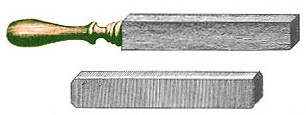
Razor Hones from Encyclopedie des
Sciences et Metiers
Vol. 7, p. 115-6, by Denis Diderot (1769)
Even the best modern stainless steel straight razor requires frequent re-sharpening, so it can be imagined how much care a period steel razor would require. Both sea surgeon John Woodall and military surgeon William Fabry recommended the surgeon have a hone in his tool chest1, "to set [sharpen] the Incision-knives, Lancets, &c."2 Woodall sternly explains that "In Germanie it is a principall proofe-peece of mastership in Surgery, for a young man to take a base and ordinary knife, and to fit it [make it fit] to shave a beard"3.
This is reiterated by French author Jean-Jacques Perret, who notes that "whether the razor is good, mediocre or bad, the sharpening stone always makes it better, correcting the imperfection of steel, and causing it to serve much longer."4 This is done by scraping bent metal from the blade's edge.
Woodall tells his surgeon's mates that "if he forget to take in his Chest a good hoane, as also a good whetstone, he may easily lacke the necessary use of a good Rasor"5. It is curious that he differentiates between a hone and a whetstone, given that a hone is a type of whetstone. He repeats
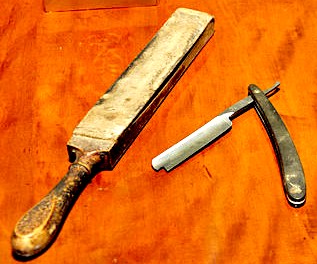
Photographer: Austin Towers (Wiki Commons)
Hone with Razor (This is a post GAoP style razor.)
this in his list of barbering case tools (seen on page 4), separating "Hoane one." and "Whet-stone one."6 Since Woodall does not provide an additional detail, we can only guess at why he makes this distinction. One definition tells us a hone is "A fine-grained whetstone for giving a keen edge to a cutting tool."7 This suggests that the whetstone Woodall is talking about is probably of a rougher grade than the honing stone.
Jean-Jacques Perret spends most of the first chapter of his book debating the different types of stones that serve as hones in detail.8 He concludes that a "hard stone is preferable, its' only flaw is that it takes more time to sharpen a razor & form a good edge, which, however, does not take more than five or six minutes longer"9.
The stone he recommends are those found "in the quarries of Liège [Belgium] and on the banks of the Meuse [which flows from France through Belgium and the Netherlands]... these stones are usually white; some are of a milk-white, and others are a little yellowish"10.
Perret advises that oil be used when sharpening a razor, telling the reader, "Olive oil is the best for sharpening, failing this, walnut oil can also be used."11
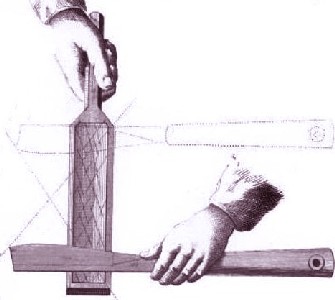
Honing a Razor from L'art du coutelier
by Jean Jacques Perret (1769)
Perret explains the procedure for honing the razor, but it is confusing (not to mention very hard to properly translate). He refers to several diagrams in his description which are not included in any copy of the book I have found. Rather than repeat a confusing description, I suggest that those interested in detail on how to properly hone a blade check out this excellent tutorial for beginners at the website Straight Razor Place.
Perret finishes by noting that after the razor is honed,
care must be taken to wipe it [the honing stone], because leaving the oil remaining on it for seven to eight days forms a kind of gum on which the razor only slips. To remedy this, it is absolutely necessary to take a piece of pumice stone and make it flat with a file or rub it on sandstone; you must rub the honing stone from time to time using clean water, or soak both of them in the water.12
1 John Woodall, the surgions mate, from "The Office and dutie of the Surgions Mate", p. 2-3 and Guliielm. Fabritius Hildanus, aka. William Fabry, Cista Militaris, Or, A Military Chest, Furnished Either for Sea or Land, p. 23; 2 Hildanus, aka. William Fabry, ibid.; 3 John Woodall, the surgions mate, p. 3; 4 Jean-Jacques Perret, La Pogonotomie, p. 84; 5 John Woodall, the surgions mate, p. 3; 6 John Woodall, the surgions mate, from "The Office and dutie of the Surgions Mate", p. 2-3; 7 Hone, thefreedictionary.com, gathered 11/17/13; 8 See Perret, p. 1-8; 9 Perret, La Pogonotomie, Interpreted by Mark Kehoe, p. 6; 10 Perret, p. 3; 11 Perret, p. 6; 12 Perret, p. 7
Barbering Instruments: Straight Razor Strop

A Paddle Strop from Encyclopedie des
Sciences et Metiers
Vol. 7, p. 116, by Denis Diderot (1769)
A strop is a piece of flexible leather which is used to realign the teeth along the edge of a razor blade. The advantage of the strop is that it doesn't remove any of the steel of the razor the way a whetstone does.
Although it doesn't look it, at a microscopic level a razor blade has jagged teeth which become misaligned through use. So while the strop doesn't technically sharpen the blade, it realigns the microscopic teeth so that the razor will cut well for a longer period.1
There are two types of strops: a hanging strop and paddle strop. Rory McCreadie tells us the hanging strop is made of soft leather backed with hard leather. It has a

Photographer: Dr. K (Wiki media) - A Modern Hanging Strop and Razor
ring for hanging at one end and a handle cut into the other end. The two pieces of leather are joined at the ring end only.2
The paddle strop has the leather mounted to a piece of wood. This is the only type described by Jean-Jacques Perret in his book and the only type shown in Denis Diderot's Encyclopedie des Sciences et Metiers, suggesting that the hanging strop may not have been as widely used at that time.
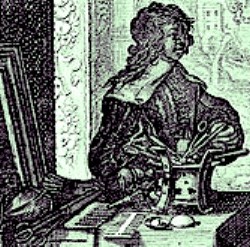
Artist: Abraham Bosse
Scissors, Combs, a Brazier... no Strops!
From Le Barbier (1630s)
In fact, no period surgical author mentions either sort of strop in their lists of equipment for a surgeon. None of the period images of barber shops feature strops either.
However, the Online Etymology Dictionary reveals that the word strop was first used in print in 1702, meaning it existed throughout much of the golden age of piracy. The two near-period books that contain lists of tools a surgeon should carry were John Woodall's
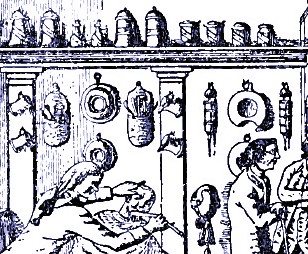
A Wall of Tools, Even Including Clyster Syringes,
But No Strops.
From Master Johann
Dietz, Surgeon in the Army of the Great Elector and
Barber to the Royal Court, p. 258
the surgions mate and William Fabry's Cista Militaris, Or, A Military Chest. Both of these were written before 1702, so it may be that the strop was not widely known or it may have had a different name at the time. (My first suspicion was that Woodall's 'hoan' was actually a strop, but I found nothing to support this.)
It may also have been that razors were stropped although a specific tool wasn't in use. Jean-Jacques Perret noted that many people "have a habit of sharpening the razor on their shoes".4 He goes on to admit that since shoe leather is prepared in oil, "shoe leather can result in a poor goodness."5
1,2 Rory W. McCreadie, The Barber Surgeon's Mate of the 16th and 17th Century, p. 42; 3 Strop, Online Etymology Dictionary, gathered 11/17/13; 4 Jean-Jacques Perret, La Pogonotomie, p. 44
Barbering Instruments: Care of Edged Tools

Razor & Case
Diderot (1769)
Being so expensive and likely to rust (because they were raw steel), edged tools such as razors and scissors had to be cared for when not in use. William Fabry explained that surgical instruments "that are for cutting, and edged, as Rasors, Scissors, Incisision Knives, &c. are to be kept in Cases, the rest are wrapt in Paper, or rather in Flannel."1 They would then be stored in the instrument chest.
Although he doesn't specifically address the care of razors, sea surgeon John Woodall does comment on how to care for lancets, which were similar in some ways to razors. He tells the surgeon's mate that he should "oile them, or anoint them with Axungie [grease], and so wrappe them in oyly cloutes, that they rust not."2 It is possible that the razor would be treated similarly, although Woodall doesn't specify this.
Jean-Jacquest Perret suggests that care must be taken to wipe the razor after it has gotten wet, although even then "there are still some water particles on the metal, which fit into the pores of the steel and gnaw the surface"3. He explains that any rust can be removed by running the cutting edge on a strop, upon which "the edge forms, resumes its vivacity, and is ready for a good shave."4
1 Guliielm. Fabritius Hildanus, aka. William Fabry, Cista Militaris, Or, A Military Chest, Furnished Either for Sea or Land, p. 12; 2 John Woodall, the surgions mate, p. 28; 3,4 Jean-Jacques Perret, La Pogonotomie, p. 50
Shaving With a Straight Razor
"Meanwhile the manservant was holding before him, where he sat reclining in large chair, a great silver basin full of soapsuds. I set about him quickly and vigorously as though I had a peasant before me. This pleased him greatly; so when it came to the razors I gripped his skin even more vigorously, and shaved him with long firm strokes of the razor. I had soon finished." (Johann Dietz, Master Johann Dietz, Surgeon in the Army of the Great Elector and Barber to the Royal Court, Translated by Bernard Miall, p. 92)
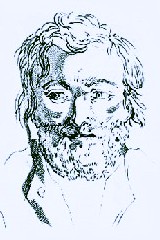
Soaping the Beard, From La
Pogonotomie
by Jean
Jacques Perret (1770)
The earliest detailed comments about the method for shaving a man that I've come across are in Jean-Jacques Perret's book La Pogonotomie, which was printed in French in 1769. This book is written to explain how a man can shave himself, not how a barber would shave another man. Still, many of his principles would apply to a period barber.
Note that while these may shed some light on how shaving was done at this time, I do not recommend relying exclusively on these instructions. There are multiple websites and videos on the web that provide much better instructions on shaving with a straight razor.
The first thing was to dampen and soap the face of the man being shaved just as barber Johann Dietz explained in the opening quote of this section. If this step was skipped, Perret says "experience tells us that when we shave a dry beard, the hair is so stiff that it arises, so to speak, as if being pulled out"1.
Perret then explains the process of shaving in a series of steps.
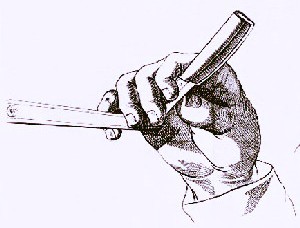
Holding a Razor, From La
Pogonotomie
by Jean
Jacques
Perret (1770)
The first step is to hold the razor in the way it is shown in the image at right, "reversing the blade back, applying the thumb on the heel, three fingers below: the middle finger should be placed on the pivot, and the little finger below the handle: this is the true position to hold a razor firmly so as not to risk of injury"2.
It should be noted that Perret's diagram shows a blade with a tang, which our period razor would not have. It is likely if this configuration was used, the thumb would rest on the opposite side of the face of the blade.
Perret's second step is to "make the skin taut in the area we want to shave, finding the most advantageous positions of your fingers, because in addition to these rules, it is good to use positions which seem the most convenient"3.
He next advises keeping "the hands loose & lightweight, almost as if dead, so that any movement starts from the wrist."4
His last step reveals that the razor should be held in the right hand (presumably Perret was right handed), while bringing the left hand to the right side of the face to hold the head. The person shaving was to put the razor's edge "slightly below the fingers, so that only the cutting edge touches the skin"5. The razor was moved downwards repeatedly. He notes that "we must also take care to wipe the razor after two or three strokes, that is to say, when it is dirty."6
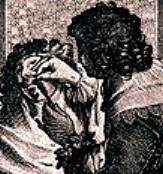
Artist: Abraham Bosse
From
Le Barbier (1630s)
Perret suggests shaving the cheeks first and then moving on to the more challenging areas around the nose and chin. He advises raising the nose up with two fingers, which would not only get it out of the way, but "at the same time you help the natural action of the muscles tightening the skin, and lengthening the upper lip"7. Care is to be taken at the corner of the mouth, particularly "watching for slack in the skin"8. Perret advises opening the mouth to tighten the skin here.
He says that the chin is difficult to shave, suggesting that the barber "must apply the left hand to the left cheek near the corner of the ear and drag the skin up to tighten it.9 For the neck, the skin is tightened by tilting the head.
The key to a good shave according to Perret is "that the point of tension [of the face] is very close to the razor's edge"10.
1 Jean-Jacques Perret, La Pogonotomie, p. 58; 2 Perret, p. 63; 3 Perret, p. 63-4; 4,5,6 Perret, p. 64; 7 Perret, p. 65-6; 8 Perret, p. 66; 9,10 Perret, p. 67

